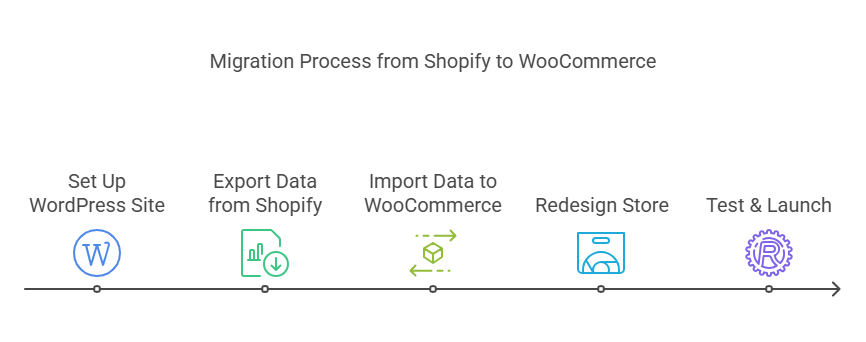Both Shopify and WooCommerce are excellent e-commerce solutions but each caters to a different need. WooCommerce is perfect for customers looking for ultimate customization, control, and WordPress integration, while Shopify is a natural choice for online store newbie looking for a hassle free, single-stop shop with hosted features and customer support. What makes most sense depends on your technical history, business needs and more.

WooCommerce vs. Shopify: Key Differences
Both WooCommerce and Shopify are powerful e-commerce platforms, but they cater to different types of users.
|
Feature |
WooCommerce |
Shopify |
|
Platform Type |
Self-hosted WordPress plugin |
Hosted e-commerce solution |
|
Customization |
High flexibility, requires technical knowledge |
Limited flexibility, easy to use |
|
Pricing |
Free plugin (hosting & extensions cost extra) |
Monthly subscription (starts at $29/mo) |
|
Ease of Use |
Requires setup & maintenance |
Beginner-friendly, all-in-one solution |
|
Payment Options |
Multiple gateways, no extra fees |
Shopify Payments & third-party options (fees apply) |
|
SEO & Blogging |
Full WordPress SEO capabilities |
Basic SEO, limited blogging tools |
|
Scalability |
Highly scalable, but depends on hosting |
Scalable with built-in hosting |
Why Choose WooCommerce?
If you want total control over customization and already have a WordPress website, WooCommerce is perfect for you. Other benefits of WordPress. In terms of solutions, it is a budget-friendly option for many businesses, as there are no monthly fees, apart from for hosting and some premium plugins. What’s more, WooCommerce connects smoothly with WordPress SEO instruments, allowing you to be high on search rankings and broaden on the internet presence.
Why Choose Shopify?
Shopify Is Best For: Beginners looking for an all-in-one, hassle-free e-commerce solution without the headache of a hosting, security or updates. It features an integrated payment system and offers customer support, allowing for a quick and simple setup. This is its best for companies that value usability more than heavy customization.
Considering WordPress Site Migration? Here’s What You Need to Know
if you have a Shopify (or other platform) shop, but prefer to transition to WooCommerce, a wordpress site migration may be the best choice. Website migration needs to be planned well otherwise will lead to losing traffic and rankings, and breaking things.
Steps to Migrate from Shopify to WooCommerce

- Set Up a WordPress Site
- Choose a reliable WordPress hosting provider.
- Install WordPress and WooCommerce.
- Export Data from Shopify
- Go to Shopify’s admin panel and export your products, customers, and orders.
- Import Data to WooCommerce
- Use plugins like WP All Import or Cart2Cart to move your store data.
- Redesign Your Store
- Choose a WooCommerce-friendly theme and customize it.
- Test & Launch
- Check for broken links, missing images, and payment gateway functionality.
- Redirect old Shopify URLs to your new WooCommerce store.
How to Transfer a Domain to WordPress
If you already have a domain but need to move it to WordPress, follow these steps:
- Unlock Your Domain
- In your current domain registrar, unlock the domain and obtain the transfer authorization code.
- Update DNS Settings
- Point your domain’s Nameservers (DNS) to your WordPress hosting provider.
- Initiate the Transfer
- In your WordPress hosting account, initiate the domain transfer using the provided code.
- Wait for Confirmation
- Domain transfers can take 24-48 hours, so be patient.
- Test & Secure Your Site
- Ensure your SSL certificate is active and test your website’s functionality.
Once completed, the transfer domain to WordPress is hosted, and you can enjoy the benefits of WooCommerce with seamless e-commerce integration.
Conclusion: WooCommerce or Shopify?
Choosing between WooCommerce and Shopify depends on your needs:
- Pick WooCommerce if you want full control, flexibility, and WordPress SEO benefits.
- Pick Shopify if you prefer ease of use, built-in hosting, and customer support.
If you’re looking to transfer wordpress site or migrate from Shopify, a WordPress migration expert can ensure a hassle-free process. Need help? Visit WPzenzo for expert WordPress services!
Frequently Asked Questions
1. Which platform is better for beginners, WooCommerce or Shopify?
Shopify is the best choice for beginners as it offers a hassle-free, all-in-one e-commerce solution with built-in hosting, security, and customer support. WooCommerce, on the other hand, requires technical knowledge and manual setup but provides more customization and control.
2. Is WooCommerce really free to use?
The WooCommerce plugin is free, but you still need to pay for hosting, premium themes, and additional plugins to unlock advanced features. Unlike Shopify, which charges a monthly fee, WooCommerce lets you control costs based on your business needs.
3. How do I migrate my Shopify store to WooCommerce?
The migration process involves setting up WordPress and WooCommerce, exporting data from Shopify, importing it into WooCommerce using tools like WP All Import or Cart2Cart, redesigning your store, and testing before launching. Proper planning ensures a smooth WordPress site migration without losing data or SEO rankings.
4. How do I transfer my domain to WordPress?
To transfer a domain to WordPress, unlock your domain in your current registrar, update your DNS settings, initiate the transfer request in your WordPress hosting account, and wait 24-48 hours for confirmation. Finally, check your SSL certificate and website functionality to ensure everything is working properly.
5. Which platform is better for SEO: WooCommerce or Shopify?
WooCommerce has better SEO capabilities because it integrates with WordPress SEO plugins like Yoast SEO, Rank Math, and All in One SEO. Shopify has built-in SEO features, but it is more limited compared to WooCommerce’s full control over SEO optimization.

